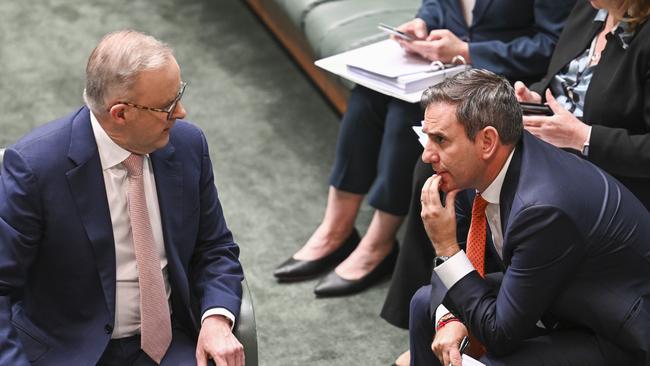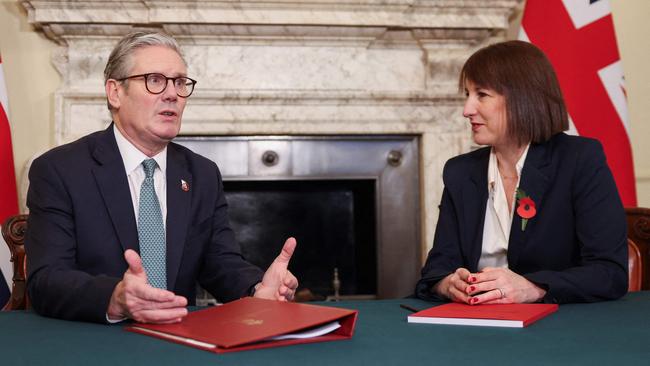
The fact is that most advanced economies operate soft – very soft – budget constraints, with substantial budget deficits and rising government debt being common features.
The standout case now is the US, where the federal budget deficit is running at more than 6 per cent of GDP. US federal government debt is more than 120 per cent of GDP and rising.
But here’s the thing: a Donald Trump or a Kamala Harris victory will make no real difference to the fiscal position of the US. Neither candidate has taken any interest in making the case for budgetary prudence, for cutting spending and reducing the deficit. Estimates put the near-term budget deficit at between 7 and 8 per cent of GDP whoever becomes president.
The Chancellor in the new Labour government in Britain has recently handed down a budget that includes $63bn in additional unfunded spending, with government debt tipped to rise significantly above the current rate of 100 per cent of GDP.
On the face of it, Australia is much better placed, although as a small, open economy there is a requirement to take particular care of budget and government debt settings. According to the Parliamentary Budget Office, national net debt is estimated to reach 36 per cent of GDP in 2027-28. Net interest payments will be about $61bn in 2027-28 or 1.9 per cent of GDP. This is higher than spending on many of our largest spending programs.

But it’s not just the federal government that matters. State government net debt is expected to rise from 13 per cent of GDP in 2024-25 to 14.8 per cent in 2027-28, a substantial increase in such a short period. State debt interest payments will go from $17.3bn to $25.7bn across that same timeframe. The worst offenders are Victoria, Queensland and Tasmania.
State governments have gone from relatively watchful and cautious budget managers to profligate spenders, including by running recurrent budget deficits. They have incurred vast debts on badly managed and sometimes ill-considered infrastructure projects, running up large uncontrolled additional liabilities. One standout example is the Metro underground rail project in Melbourne that was expected to cost $11bn when construction began; it is now tipped to cost more than $14bn and to be much delayed. But this project pales in comparison with the much-criticised Suburban Rail Loop, which may end costing as much as $200bn.
The recent Queensland election campaign also contained some important messages. The Labour premier had no problem promising to commit an additional $33bn in recurrent spending to fund giveaway schemes such as electricity rebates, free school lunches, 50c public transport fares and sports vouchers for children.
Substituting private spending with government-funded handouts has become far too familiar.
The broader point is that state governments increasingly spend money like confetti being tossed at a wedding. There is always another lobby group to appease, a worthy cause to fund and new big projects to announce. Teachers, healthcare workers and other public sector workers must be paid more.
Little regard is given to achieving value for money, with the efficiency of government provision largely ignored.


When there are effectively no budget constraints, this is what happens. Buying votes with other people’s money is a strong temptation for many politicians.
Many years ago, the operation of the Loan Council constrained the borrowing capacity of state governments, but this eventually was ditched.
In theory, state governments should be keen to retain their credit ratings lest a downgrade add to the burden of interest payments.
It is more than passing strange that the credit ratings agencies have not adjusted the ratings of the more irresponsible states; there is an assumption no doubt that the federal government would bail out a state if it got into real trouble.
Returning to the federal sphere, why is it that Jim Chalmers decided to abandon fiscal rules governing the budget? His Labor predecessor as treasurer, Wayne Swan, had a set of rules although several were breached in practice.
It was Coalition treasurer Joe Hockey who decided to remove the legislated debt ceiling in 2013, arguably a retrograde step. However, even as Covid continued to take a toll, Coalition treasurer Josh Frydenberg retained a set of fiscal rules that included “stabilising and then reducing gross and net debt as a share of the economy; targeting a budget balance, on average, over the course of the economic cycle; and maintaining a tax-to-GDP ratio at or below 23.9 per cent of GDP”. Arguably, these rules don’t amount to a hard budget constraint, but they do at least establish some guardrails, particularly the maximum tax take.
By comparison, Chalmers prefers the word salad approach while walking away from the cap on the tax take.
The fiscal profligacy apparent in many advanced countries, including here, raises the question: how will this end? In extreme cases such as Argentina, we see the ultimate outcomes of a collapsing currency, runaway inflation and widespread suffering. Ultimately a dramatic reset is the only solution, which carries its own risks and hardships.
The US is in a slightly different position than the rest of the world because the US dollar remains essentially a numeraire currency. In the case of Japan, which is another highly indebted country, a great deal of the government debt has been funded internally through the savings of its own citizens. Australia fits neither of these cases.

The truth is that there are some real gains from governments having to weigh up the costs and benefits of spending and to be careful about raising taxes in case saving and investment are discouraged. Trade-off thinking makes for good decision-making. Sadly, there is far too little of it among federal and state politicians. The rapid expansion in government spending has been associated with collapsing productivity and a crowding out of private sector investment.
There are also important moral elements to this issue. Is it right for the current crop of politicians to be amassing debts for future generations to pay off? Do we also underestimate the loss of individual freedoms when governments begin to assume roles that should, by rights, be undertaken by individuals and families? There are almost always conditions attached to seemingly generous handouts.
To be sure, those freedom-fighting economists, Friedrich Hayek and Milton Friedman – they both won Nobel prizes – are deeply unfashionable these days. They both argued that a burgeoning and omnipotent state is ultimately a road to diminished freedoms for citizens. Just as turkeys won’t be voting for Christmas, current politicians won’t be in favour of hard budget constraints. The pity is that we could all ultimately be much better off if they were.







Is there a case for a hard government budget constraint in which so much, and no more, can be spent each year? Should governments stick to clearly articulated fiscal rules? In this way, could there be some assurances that government spending is directed at the most important ends, any debt accumulation is reasonable and the overall tax take is capped?